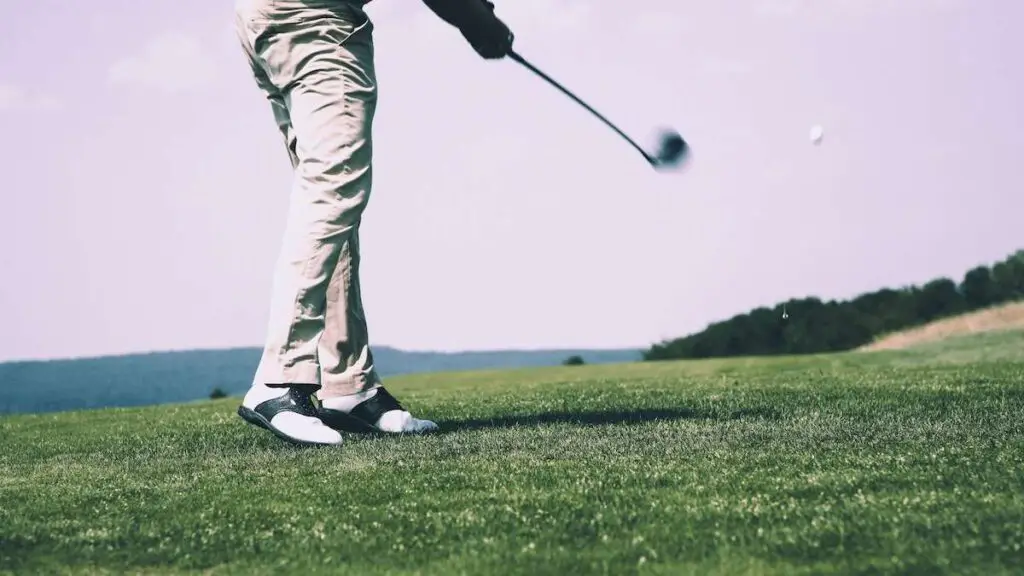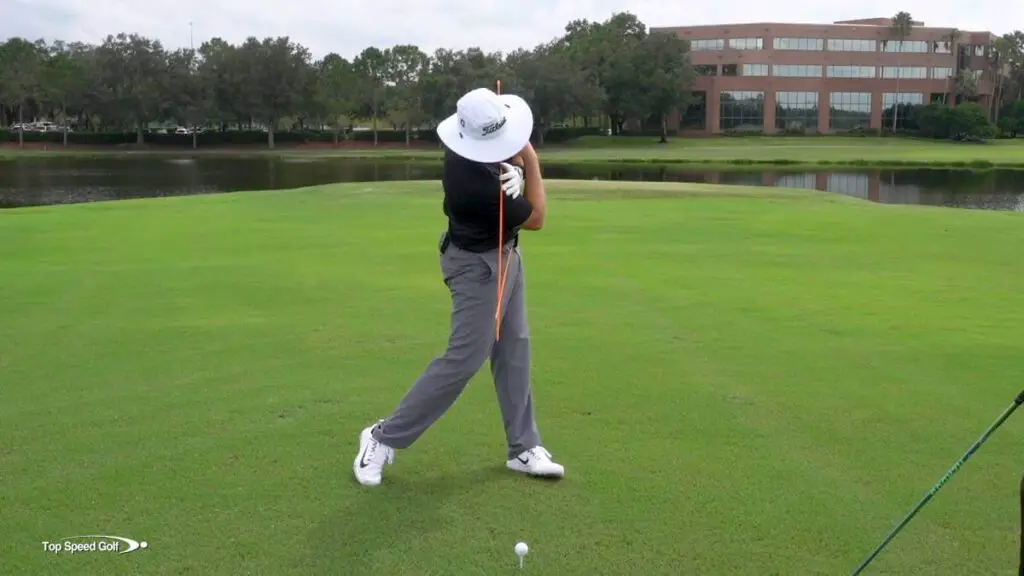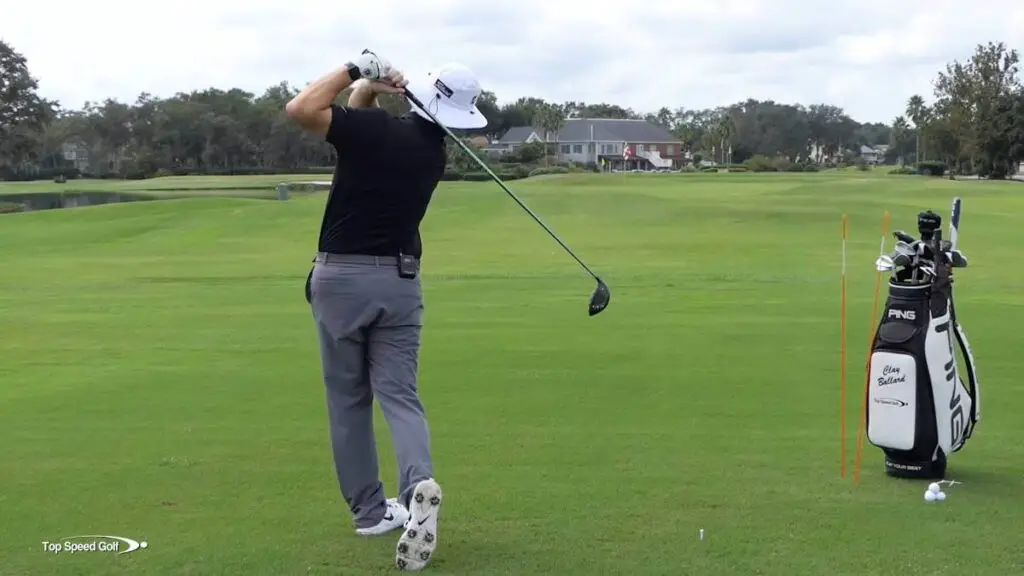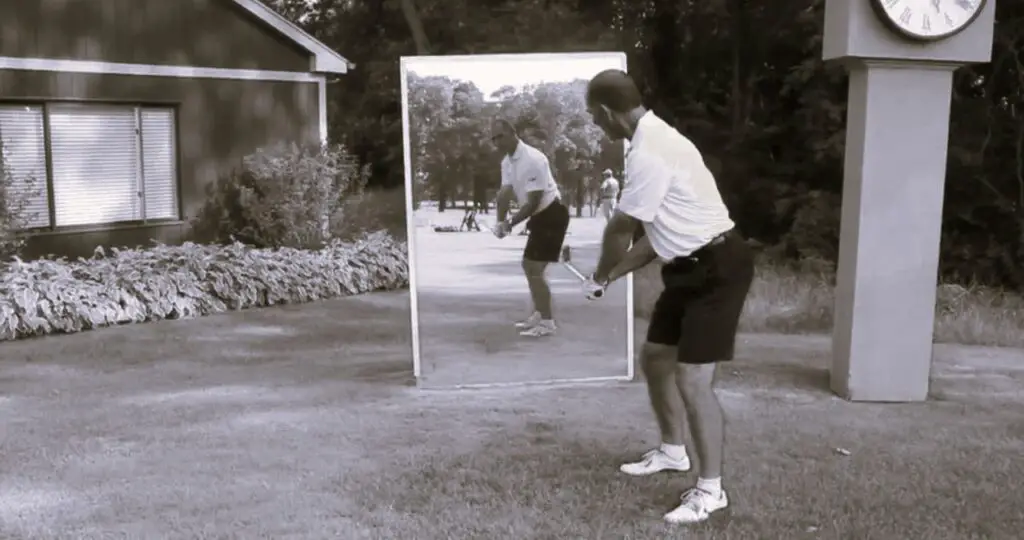In this Article
Clearing your left hip properly in the downswing allows maximum power generation and improves accuracy. This comprehensive guide teaches you the mechanics of left hip clearance, step-by-step instructions, common mistakes to avoid, effective drills to practice, and tips to enhance your hip rotation for more distance and consistency in your golf swing.
For those looking to improve their golf swing, one aspect often overlooked is proper hip movement, specifically clearing left hip in the downswing. As an avid golfer myself, I used to struggle with inconsistencies in my shots until I learned the importance of clearing my left hip. In this article, I’ll explain what clearing your left hip in the downswing means, why it’s so important for power and accuracy, and provide a step-by-step guide to help you master this movement.
When I refer to “clearing the left hip” in the golf swing, I mean the movement of rotating your left hip away from the target line as you transition from the backswing into the downswing. This allows your torso to fully rotate through impact, generating maximum power. It also positions your body correctly to strike the ball solidly and control the face angle for improved accuracy.
Some golfers believe the limited hip turn is best for consistency. However, restricting your hips can make it harder to create power and prevent you from hitting your full potential. Properly clearing your left hip is essential for unleashing the full capabilities of your swing.
Throughout this article, I’ll break down the mechanics of left hip clearance and provide actionable tips you can implement right away. You’ll learn common mistakes to avoid, step-by-step instructions for how to properly clear your left hip, and drills to ingrain this movement pattern. With a focused effort on rotating your hips to their full capacity, you can gain significant yardage and take your ball-striking skills to the next level.
By the end, you’ll have a comprehensive understanding of the role your left hip plays in the swing, and how to optimize its movement for repeatable power and precision. Let’s get started by examining the detailed mechanics of clearing your left hip and how it can transform your golf game.
Table of Contents
The Mechanics of Clearing Left Hip in the Downswing: A Detailed Breakdown

Now that we’ve covered the importance of left hip clearance, let’s examine the actual mechanics of this movement and its role in generating power and accuracy.
What Happens When You Clear Your Left Hip
As a right-handed golfer moves into the downswing, the first move should be clearing your left hip out of the way to make room for the rotation of your torso. As you initiate the downswing, your left hip should begin rotating open by turning clockwise away from the target line if you’re looking down at the ball.
Meanwhile, your right hip and leg start driving forcefully towards the target, which pulls your torso into a fully rotated position. As the left hip continues opening, it creates the space necessary for your torso to unwind powerfully through the ball at impact.
The Role of the Left Hip in Power and Accuracy
There are a few key reasons why clearing the left hip properly is so important for generating both power and accuracy in your golf swing:
- It allows your torso to fully rotate through impact, which is where most power is generated in the swing. Restricting hip turn limits torso rotation.
- It keeps your hips and legs out of the way of the swing arc, preventing casting and clearing room for your arms to swing freely.
- It encourages the proper weight shift to your front side, promoting a forward swing direction and solid ball striking.
- It maintains your spine angle and posture, which are key for consistent ball striking.
- It sets your body in the correct alignment to control face angle through impact for improved accuracy.
The Relationship Between Hip Movement and Other Body Parts
Clearing the left hip properly promotes the efficient sequence of movements between your lower and upper body required for an effective golf swing:
- It allows your legs and hips to drive force into the ground on the downswing, stabilizing your lower body.
- This force transfers up through your torso as you unwind, adding rotational power to your swing.
- It keeps your upper body behind the rotating hips and legs, maintaining proper sequencing.
- Your rotating torso pulls the arms and club down into the slot naturally for an optimal swing plane.
Common Mistakes Golfers Make
Having examined the ideal hip movement pattern, let’s look at some common mistakes golfers make:
- Failing to fully rotate the left hip open in the downswing
- Sliding the left hip towards the target rather than turning it open
- Swaying laterally rather than rotating the hips open
- Early extension of the hips towards the target before impact
- Disconnecting the upper body from the lower body.
The Impact of These Mistakes
These faulty hip movements have several detrimental effects on your swing:
- Reduced torso rotation limits swing power and consistency.
- Sliding or swaying hips causes fat and thin shots by changing your swing path.
- Early extension makes it harder to compress the ball properly.
- Disconnection between the upper and lower body leads to inconsistent strikes.
How to Avoid These Mistakes
The good news is with the right adjustments, you can get your hips clearing correctly:
- Maintain spine angle in transition to keep your upper body behind the hips.
- Feel like your right hip is driving forcefully toward the target in the downswing.
- Rotate your hips fully open by exaggerating the feeling.
- Keep your head still as your hips turn to avoid swaying.
- Stay centered over the ball in transition to prevent sliding.
Now that you understand the vital role the left hip plays and how to get it moving properly, let’s move on to a step-by-step guide to master clearing your left hip in the downswing.
Step-by-Step Guide: How to Properly Clear Your Left Hip
Proper Setup and Alignment
First, your setup and alignment are key. Experiment with adjustments like standing closer to the golf ball to find your optimal stance. Aim your feet, knees, hips, and shoulders parallel to your target line. Place your weight evenly on both feet with a slight knee flex. This balanced starting position makes it easier to properly rotate your hips.
Initiating the Downswing

As you transition into the downswing, maintain your spine angle. Don’t sway laterally or bend over and lose posture. Keep your head still as your lower body starts driving down and rotating towards the target.
Initiate the downswing by firing your right glute and allowing your right hip to move assertively toward the target. Feel like your right leg is stomping down powerfully. This forces your hips to begin clearing.
Rotating and Clearing the Hips
As your right hip moves forward, simultaneously turn your left hip open by rotating it clockwise away from the target line. Complete this left hip rotation fully so your hips become perpendicular to the target at impact.
Time the sequencing so your upper body follows your hip turn rather than leading it. Maintain right hip drive throughout the downswing as you continue rotating your hips and torso together through impact.
Maintaining Balance and Control

To control your balance, keep your weight centered over the balls of your feet. Avoid swaying sideways or leaning during the hip turn. Let your rotating core pull your arms down into the slot.
Generating this forceful hip rotation through impact can feel awkward at first. Take it slowly and exaggerate your hip turn. The more you groove this motion pattern, the more natural it will feel.
With practice, clearing your left hip properly will begin to synchronize the movements of your lower and upper body for maximum power. Keep these steps in mind and implement purposeful reps to make it a natural part of your swing.
Now let’s look at some great practice drills to really reinforce proper left hip clearance in your downswing.
Drills for Success: Practice Techniques for Clearing Your Left Hip
Implementing targeted drills into your practice routine can really help ingrain proper left hip clearance in your golf swing. Isolating the hip motion and exaggerating it repeatedly will build the correct motion pattern. Try incorporating some of these effective drills:
No Turn Casting Drill
This drill isolates the hip turn you want to perform without the influence of your arms swinging. Set up to a ball as normal. Make your regular backswing turn then start the downswing by driving your right hip towards the target and clearing your left hip open. Feel the separation and re-connection of your upper and lower body.
The key is to make a full left hip clearing action and right hip drive without letting your arms swing at all. Keep your arms passive and let your lower body rotate your core. The resistance of holding your arms still forces your hips and core to generate more power. Do sets of 10-15 reps to really groove the feeling of casting your hips fully open on the downswing.
Impact Bag Drill
Set up to hit soft half-swings into an impact bag. Make an abbreviated backswing then swing down focusing on turning your hips maximally through the point of impact. Let your arms relax while your hips and core rotate fully to make solid contact with the bag.
Exaggerate clearing your left hip and driving your right hip to maximize rotational speed and power into the bag. This engrains the feeling of fully releasing and rotating your hips to unleash power through impact. Do 2-3 sets of 10 reps, gradually swinging a little harder and longer as it starts to feel more natural.
Mirror Drill

Perform the hip clearing motion in front of a mirror to check that your hips are fully rotating open. Set up as if to hit a ball then make your normal backswing. Drive your right hip towards the target on the downswing while clearing your left hip open. Your left hip should rotate perpendicular to the target line with no lateral slide. Verify your right hip is driving towards the target as well.
Use the visual feedback from the mirror to self-correct any faults in your hip motion. Are you getting full clearance of your left hip? Is your right hip moving assertively to the target? Once it feels right, try it with your eyes closed to rely purely on body feel instead of vision. Then check yourself again in the mirror to see if your motion matches your intent.
Half-Swing Follow Through Drill
Hit half-shots focused on following through with a full clearing of your left hip after impact. Make an abbreviated backswing then concentrate on maintaining your left hip turn open towards the target after you strike the ball. Hold your finish position for 2-3 seconds feeling your hips fully released.
This teaches your body to continue the hip turn well after impact, eliminating any urge to decelerate too early. Let the momentum of your rotating core naturally swing your arms through the ball. Repeat with mid irons to ingrain a powerfully clearing left hip.
Rotation vs. Swaying
As you perform these drills, be careful not to over-rotate your hips laterally. You want to turn your hips open rather than swaying your whole body towards the target. Maintain balance centered over the balls of your feet. Let your core pull the motion rather than swaying yourself off the ball.
Benefits Beyond Hip Turn
When executed correctly, these focused hip-clearing drills will synchronize your lower and upper body in the downswing. This sequence promotes proper clubface control and more solid ball striking. The increased rotational power will naturally carry over into full-swing reps.
Dedicated practice with these drills can ingrain optimal left hip clearance and benefit many aspects of your swing. Next, let’s go over some additional tips to enhance your downswing.
Tips and Tricks: Enhancing Your Downswing with Proper Left Hip Clearance
Now that we’ve covered the mechanics and drills for better left hip clearance, I want to share some additional tips and tricks to help you optimize this movement pattern:
Maintain Spine Angle in Transition
A common error is straightening up or bending over too soon on the downswing and losing your spine angle. This causes your upper body to lift or shift towards the target prematurely, making it harder for your hips to properly clear on plane.
Maintain your spine angle from the top of the backswing as you start down. Feel like your upper body is staying more passive as your hips drive down and around. Keeping your upper body quiet longer lets your hips fully clear before your shoulders start to rotate.
Engage Your Core Muscles
Proper core engagement and tension support your body as your hips unleash power through impact. Practice squeezing your abdominal muscles gently on the downswing while also keeping your glutes firm.
This athletic stance stabilizes your rotation so you can swing aggressively through the ball. Take some light practice swings focusing solely on core and glute activation in the transition and downswing.
Control Your Weight Shift
As you clear your hips open, your weight must simultaneously shift towards your front foot. Drive your right knee towards the target as you coil your hips around. Let your torso pull your arms down rather than sliding your body or swaying laterally.
Making practice swings while paused in your right hip cleared halfway-back position helps ingrain the proper posts and releases from that point. Do this drill both with and without a ball to optimize your weight shift timing.
Increase Hip Turn Gradually
Trying to force your hips to over-rotate too quickly can throw off your sequence and balance. Allow your hip turn to build progressively on the downswing. Clear your left hip steadily while driving your right side through impact.
Start your downswing slowly and let your rotational speed increase as your hips unwind through impact. Be patient on the firing sequence and rely on your flexing right knee to pull the motion.
Avoid Rushing the Transition
Rushing your transition or starting your downswing too quickly prevents proper sequencing. Your upper body lifts too early, blocking your ability to fully clear your hips. Practice some slow-motion swings, exaggerating the pause at the top of your backswing.
Keep Your Head Still
Let your clearing hips swing your torso around rather than swaying your whole body from your head and shoulders. As you start down, feel like your head stays still in space as your hips rotate underneath. This keeps you centered throughout the swing.
Continue Reps to Make it Natural
It will take repetition to make this powerful hip turn feel natural in your full swing. But dedicating time to purposeful practice with the tips covered in this article will help you master clearing your left hip fully, adding yards to your drives while improving consistency.
I know first-hand the difference optimizing your hip motion can make in your ball striking and distance. Stick with it, and this crucial piece of the puzzle will start to really click!
Conclusion
Throughout this article, we’ve explored the importance of properly clearing your left hip on the downswing and how it can transform your golf swing. When executed correctly, this movement pattern unlocks greater power, consistency, and control in your shots.
By reviewing the detailed mechanics of left hip clearance, I hope you now better understand what needs to happen in the transition from backswing to downswing. We discussed common mistakes golfers make, and how to avoid them by focusing on the proper motions – maintaining spine angle, driving the right hip, and fully rotating the left hip out of the way.
The step-by-step breakdown should provide a clear guide to ingraining this sequence in your own swing. Implementing targeted drills like the no-turn casting drill, impact bag drill, and half-swing follow-throughs will help groove the correct motions through repetition.
Additionally, tips like engaging your core, controlling your weight shift, and taking it slowly at first can help optimize your hip-clearing technique. Keeping your head still, maintaining an ideal posture, and not rushing are key pointers as well.
Mastering left hip clearance has made a huge difference in my own ball striking and power. When you properly sequence your lower and upper body, it synchronizes your downswing for consistency and maximal force transfer into the ball.
Don’t expect it to feel natural right away. But stick with purposeful practice using the tips in this guide, along with a focus on fundamentals like proper golf stance. In time, you’ll experience better ball compression, increased distance, and more repeatable accuracy from shot to shot.
The journey to an efficient golf swing never ends. We can always refine aspects of our game. I encourage you to focus on continuing education and practice to hone your skills. Optimizing how you clear your left hip on the downswing is one piece of that puzzle.
Now you have a great framework and drills to improve this movement pattern. All that’s left is to put this knowledge into action on the range. Here’s to unleashing your inner power and taking your swing to the next level!

